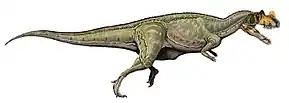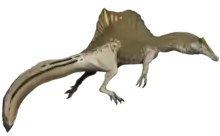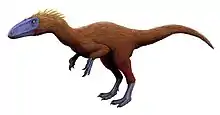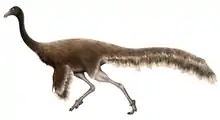Nanuqsaurus
Nanuqsaurus (meaning "polar bear lizard") is a genus of carnivorous tyrannosaurid theropod known from the Late Cretaceous period (early Late Maastrichtian stage) Prince Creek Formation of the North Slope of Alaska, United States. It contains a single species, Nanuqsaurus hoglundi, known only from a partial skull.
| Nanuqsaurus | |
|---|---|
 | |
| Reconstructed skull with cast of the holotype in place, Perot Museum | |
| Scientific classification | |
| Kingdom: | Animalia |
| Phylum: | Chordata |
| Clade: | Dinosauria |
| Clade: | Saurischia |
| Clade: | Theropoda |
| Family: | †Tyrannosauridae |
| Subfamily: | †Tyrannosaurinae |
| Genus: | †Nanuqsaurus Fiorillo & Tykoski, 2014 |
| Type species | |
| †Nanuqsaurus hoglundi Fiorillo & Tykoski, 2014 | |
Description
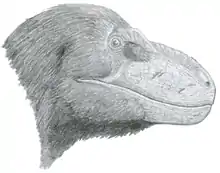
Nanuqsaurus has been estimated to have been about 5–6 meters (16–20 ft) long, about half the length of Tyrannosaurus rex.[1][2][3] Its weight has been estimated to be 500–900 kilograms (1100–2000 lbs).[1][3] This diminutive size was postulated by Fiorillo and Tykoski as being an adaptation to its high-latitude habitat.[4]
Nanuqsaurus bears a particularly shaped ridge on its head indicating the carnivore was related to Tyrannosaurus rex. The length of the reconstructed skull, based on the proportions of related animals, is 60–70 cm (24–28 in).[4]
Classified as a tyrannosaurine, Nanuqsaurus is diagnosed by: a thin, rostrally forked, median spur of the fused parietals on the dorsal skull roof that overlaps and separates the frontals within the sagittal crest, frontals with a long, rostrally pointed process separating the prefrontal and lacrimal facets and that the first two dentary teeth are much smaller than the dentary teeth behind them.[4]
Discovery and naming
In 2006, at the Kikak-Tegoseak Quarry, in North Slope Borough in the north of Alaska, fossils were found of a medium-sized theropod, with an estimated skull length of 600–700 mm (24–28 in). These were first referred to Gorgosaurus and later to Albertosaurus. After preparation in the Perot Museum of Nature and Science (Dallas Museum of Natural History) it was recognized these represented a species new to science.[4] The holotype, DMNH 21461, has been found in a layer of the Prince Creek Formation, dated at 69.1 million years. It consists of a partial skull with a lower jaw, which were found very close together. It contains the nasal branch of the right maxilla; a partial skull roof including partial parietals, frontals and a right laterosphenoid; and the front of the left dentary.[4] The specimen is from a fully mature individual, as it has a smooth nasal contact.[4]
Nanuqsaurus was first described and named by Anthony R. Fiorillo and Ronald S. Tykoski in 2014. The type species is Nanuqsaurus hoglundi. The generic name is derived from the Iñupiaq word for "polar bear", nanuq, and the Greek word sauros, meaning "lizard". The specific name honors the philanthropist Forrest Hoglund, for his work on philanthropy and cultural institutions.[4]
Classification


Nanuqsaurus is a highly derived tyrannosaurine. It is considered the sister taxon to a clade containing Tyrannosaurus, Tarbosaurus, and probably Zhuchengtyrannus. Below is a cladogram illustrating the relationships of all tyrannosaurid genera:[4]
| Tyrannosauridae |
| ||||||||||||||||||||||||||||||||||||||||||||||||||||||||||||
Paleobiology

According to paleontologists, about 70 million years ago northern Alaska was a part of an ancient subcontinent called Laramidia and experienced cold weather and extreme changes in the amount of daylight during the year, with seasons in which food was not readily available. Prey availability likely would have increased substantially during the summer, but then declined in the dark winter, leaving predators with little to eat.[4]
Fiorillo and Tykoski stated that this lack of food might explain Nanuqsaurus's unusually small size for a tyrannosaur, as a large animal cannot survive on scarce resources. Nanuqsaurus may have evolved a smaller size because of the decrease in year-round food supply, caused by the colder temperatures. In contrast, it was also found that the normal length of Troodon was 50% larger in Alaska compared to more southerly areas, possibly because a larger eye size allowed it to hunt more effectively in low-light conditions.[4]
Paleoecology

The holotype specimen assigned to Nanuqsaurus comes from the Maastrichtian age Prince Creek Formation. At an age of 71–68 million years ago, the Kikak-Tegoseak Quarry region Prince Creek Formation dates to the early Late Maastrichtian. An average age found in dating rocks from the formation is 69.1 ± 0.3 million years ago, so it is likely that Nanuqsaurus is from around that age. The formation is along the Colville River on the North Slope Borough, and is made up of alluvial sediments. It is one of a few dinosaurs to live at very high-latitude areas.[4][5]
See also
References
- Molina-Pérez & Larramendi 2016. Récords y curiosidades de los dinosaurios Terópodos y otros dinosauromorfos, Larousse. Barcelona, Spain p. 259
- http://news.nationalgeographic.com/news/2014/03/140313-new-species-dinosaurs-tyrannosaurus-rex-animals-science/
- Paul, Gregory S. (2016). The Princeton Field Guide to Dinosaurs 2nd Edition. New Jersey: Princeton University Press. p. 114.
- Fiorillo, A. R.; Tykoski, R. S. (2014). Dodson, Peter (ed.). "A Diminutive New Tyrannosaur from the Top of the World". PLoS ONE. 9 (3): e91287. doi:10.1371/journal.pone.0091287. PMC 3951350. PMID 24621577.
- Fiorillo, Anthony R.; Gangloff, Roland A. (2000). "Theropod teeth from the Prince Creek Formation (Cretaceous) of northern Alaska, with speculations on Arctic Dinosaur paleoecology". Journal of Vertebrate Paleontology. 20 (4): 675. doi:10.1671/0272-4634(2000)020[0675:TTFTPC]2.0.CO;2.
